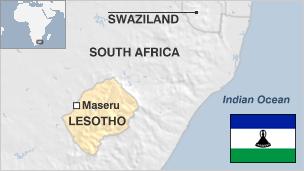

-
19 March 2015
- From the section Africa

The Kingdom of Lesotho is made up mostly of highlands where many of the villages can be reached only on horseback, by foot or light aircraft.
During the winter shepherds wearing only boots and wrap-around blankets have to contend with snow.
While much of the tiny country, with spectacular canyons and thatched huts, remains untouched by modern machines, developers have laid down roads to reach its mineral and water resources.
The Lesotho Highlands Water Project was completed in the 1990s to supply South Africa with fresh water.
Resources are scarce – a consequence of the harsh environment of the highland plateau and limited agricultural space in the lowlands. So, Lesotho has been heavily dependent on the country which completely surrounds it – South Africa.
Over the decades thousands of workers have been forced by the lack of job opportunities to find work at South African mines. South Africa has on several occasions intervened in Lesotho’s politics, including in 1998 when it sent its troops to help quell unrest.
The former British protectorate has had a turbulent, if not particularly bloody, period of independence with several parties, army factions and the royal family competing for power in coups and mutinies. The position of king has been reduced to a symbolic and unifying role.
Lesotho has one of the world’s highest rates of HIV-Aids infection. A drive to encourage people to take HIV tests was spurred on by former Prime Minister Mosisili, who was tested in public in 2004.
Poverty is deep and widespread, with the UN describing 40% of the population as “ultra-poor”. Food output has been hit by the deaths from Aids of farmers.
Economic woes have been compounded by the scrapping of a global textile quota system which exposed producers to Asian competition. Thousands of jobs in the industry have been lost.

